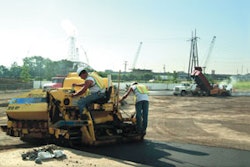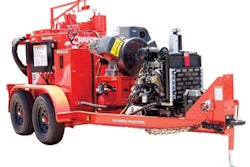Since 1990, construction sites larger than 5 acres and municipal separate storm sewer systems (MS4s) serving populations over 100,000 have had to abide by the rules of the Environmental Protection Agency’s (EPA) National Pollutant Discharge Elimination System (NPDES) Storm Water Program. This program was put in place to protect the country’s waterways from sedimentation buildup.
On March 10, 2004, Phase II of the NPDES rule went into effect, expanding the regulations to include small MS4s and any construction site larger than 1 acre. Construction sites smaller than 1 acre but part of a larger common plan of development must also abide by these rules. In addition, states, counties and municipalities can impose their own runoff/erosion control rules on top of the EPA’s baseline rule. This means that small contractors and sub- contractors have many regulations to keep track of in order to comply with the requirements of Phase II.
The Phase II Final Rule mandates that the owner or operator of a construction site must: 1. Submit a Notice of Intent (NOI) containing general information about the project to either the EPA or state agency. This means you have obtained permit coverage. 2. Develop and implement a Storm Water Pollution Prevention Plan (SWPPP) with appropriate Best Management Practices (BMPs) to control runoff and erosion on site. 3. Submit a Notice of Termination (NOT) when final stabilization of the site has been achieved as defined in the permit, or when another operator has assumed control of the site.
In developing the SWPPP, a construction site manager must come up with a set of BMPs, or steps to control erosion and runoff on the site. Failure to do so leaves a site in violation of the Clean Water Act and can result in fines of up to $27,500 per day, per violation.
Some BMPs are general housekeeping items such as monitoring trucks regularly for leaks, providing portable bathrooms for workers and having trash dumpsters on site to collect garbage and construction waste. Other BMPs are more directly targeted at minimizing the amount of exposed soil to assist storm water to infiltrate the soil instead of turning into runoff and keeping sediment on site.
Methods To Minimize Erosion
A proactive step to keep storm water from developing into runoff is to inhibit erosion. One of the easiest methods is to leave natural vegetation on a construction site intact as long as possible. When the natural vegetation is gone, you will need erosion control devices to protect exposed soils from being carried away by rain. These devices need to break up rain water and give it time to soak into the earth before it gets a chance to carry sediment off the site.
One erosion control method is erosion mats, which are made from either synthetic materials or biodegradable materials such as jute or straw. Mats made of earthen materials are often used to inhibit soil disturbance while nurturing seed planted underneath. As the biodegradable mats fall apart, they act as fertilizer for the vegetation growing up to replace it. The mats can also be used on their own as a temporary protector of exposed soil.
Erosion hampering stabilization chemicals can also be used. These materials can be sprayed alone on the soil for temporary control, or they can be mixed with seed and sprayed on an area to stabilize the soil while natural vegetation begins to grow.
Another popular way to inhibit erosion is to hydroseed or to cover exposed soil with loose straw, bark or rock. Finn Corp., a green industry company in Ohio, makes a variety of sizes of hydroseeders, straw blowers and bark blowers.
According to Marc Bowers, vice president of marketing at Finn, straw blowers act as a temporary, albeit imperfect, quick fix for covering exposed soil. A pneumatic bark blower can disperse heavier materials, such as wood chips or compost, which give you a longer lasting layer of erosion control.
For temporary or permanent planting on a construction site, Bowers recommends using hydroseeders. This equipment mixes together seed, mulch and additives such as fertilizers to create a slurry substance.
“When you spray the slurry on the ground, the mulch fibers hold your seed and additives on top of the soil, effectively creating a cap,” Bowers explains.
“This does a couple things. It keeps the soil underneath from getting direct water runoff. It keeps the soil from taking a direct water hit. And it also holds the nutrients the seed needs to get started right there where the seed is. It can hold them in suspension until it gets regular water. But as soon as you start watering it, several weeks later you’re going to need to mow it. It starts growing quickly, and as soon as you have root, it’s the root that you’re counting on to hold the soil in place. Also, because you are planting from seed, when you hydroseed with the proper soil amendments and additives, you get a healthier root structure than with sod.”
Options For Runoff Control
Stopping all erosion and eliminating all chances of runoff is a high order. You have to expect some sediment to collect in storm water during a heavy storm. Retention ponds, sediment basins or traps and protection of existing water-flow channels on site can help control this runoff.
Silt fencing is a very common method for temporarily containing runoff. The fabric that makes up the fence is permeable, allowing water to slowly drain through while capturing sediment. Silt fence can be installed manually. A trencher is used to create a trench, workers place the fabric into the hole, secure it with posts, then backfill and compact the soil around the trench.
Compacting the soil after manual installation is a critical factor often left undone, notes Tom Carpenter, a certified professional in erosion and sediment control, and owner of Carpenter Erosion Control, developer of the Tommy Silt Fence Machine. He cites an EPA study, co-sponsored by his company, which found that compaction is the key to ensuring silt fence remains firmly in place.
Equipment specifically designed for silt fence installation serves as an alternative to manual methods. The equipment slices through the ground with minimal soil disturbance, then a wheel following the slicing mechanism pushes the fabric into the ground. Workers later come through and attach the fence to either wooden or metal posts and compact the soil next to the fence.
“A machine installation is the same every time,” Carpenter points out. “You’re not excavating any soil, so you can slice it in and all the soil is still on either side of the fence. Then you compact it with the wheel of your vehicle and you have a silt fence that won’t wash out on the bottom.”
Installation time is also greatly reduced, says Carpenter. “You eliminate soil excavation and consequent backfilling,” he explains. “And a silt fence machine is more maneuverable on construction sites, saving double to triple the installation time.”
Like all other BMPs, a silt fence needs to be inspected and maintained, with intervals more dependent on weather than on time. “If it rains an inch every day, you might have to replace the silt fence every day because it’s full of sediment,” Carpenter says. “But if it doesn’t rain for three months, then one silt fence might last a long time.”
Whether you’re working on a 50-acre development project or a 1-acre parking lot, adherence to the EPA’s storm water runoff rules can help save your company from facing steep fines, and help save our nation’s waterways for the enjoyment of generations to come.




















